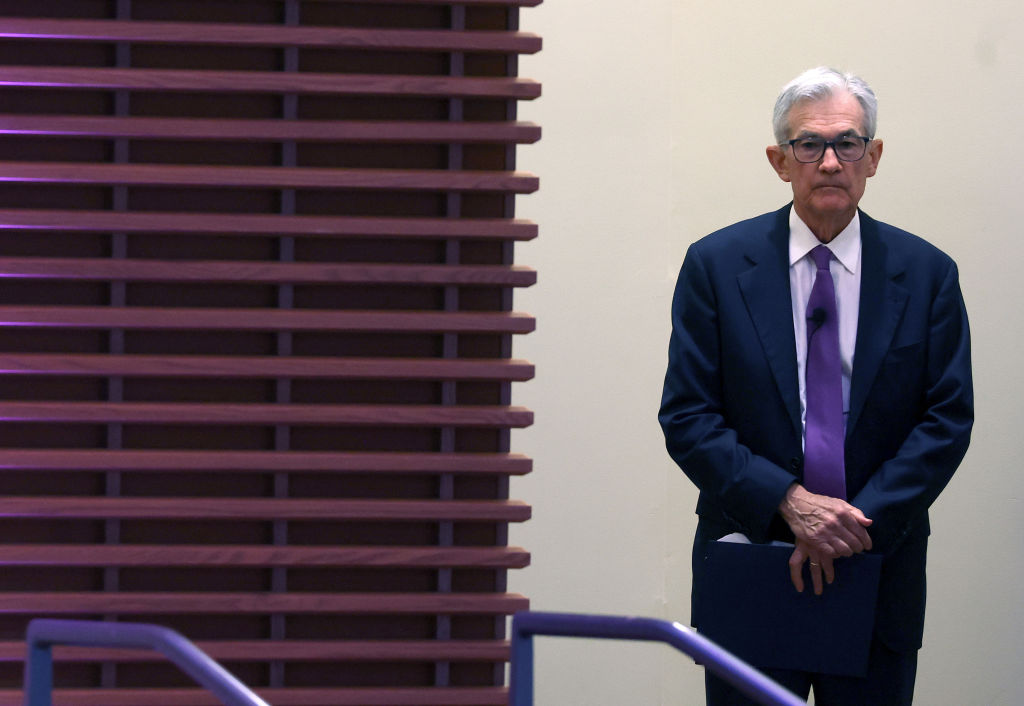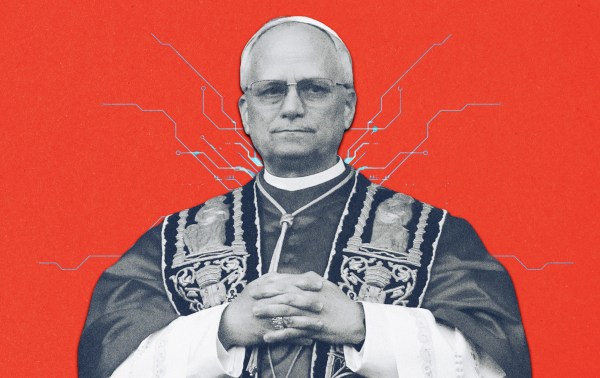Happy Friday! Prince Harry is now officially a resident of the United States. In response to an actual member of the British royal family deciding he likes America better—and on behalf of the Founding Fathers—we’d just like to say: 🇺🇸 🦅.
Taylor Swift was quick to react to the news, including a song called “So Long, London” on her new album that came out this morning.
Quick Hits: Today’s Top Stories
- Unnamed U.S. and Israeli officials said early Friday morning that Israel had struck Iran in a retaliatory attack that followed Tehran’s launch of more than 350 explosive drones and missiles at Israel last weekend. While the scale of the purported Israeli drone strike was not immediately clear, the target seemed to have been a military base near the central Iranian city of Isfahan. Early reports suggested the Iranian nuclear facility near the city was not a target. Senior U.S. and Israeli officials had met virtually on Thursday to discuss the potential Israeli invasion of Rafah, the southernmost city in Gaza, after Iran’s weekend attack on Israel postponed a planned trip by Israeli officials to Washington, D.C. American officials have expressed concerns that a ground assault on Rafah, where more than a million Gazans are thought to be sheltering, would result in significant civilian casualties. Meanwhile, the U.S., in concert with Western allies, announced additional sanctions against Iran on Thursday, targeting the country’s missile and drone program.
- Police in Germany arrested two men—reportedly of dual German and Russian citizenship—on Wednesday whom authorities alleged were Russian agents planning to bomb key German military and industrial sites in an effort to disrupt the delivery of military aid to Ukraine. “It is a particularly serious case of alleged spy activity for [Russian President Vladimir] Putin’s criminal regime,” German Interior Minister Nancy Faeser said on Thursday. The Russian embassy in Germany denied the allegations.
- Google fired 28 employees on Wednesday over their participation in sit-ins to protest the tech giant’s cloud computing contracts with the Israeli government, which have been in place since 2021. “Physically impeding other employees’ work and preventing them from accessing our facilities is a clear violation of our policies, and completely unacceptable behavior,” a company spokeswoman said in a statement. Meanwhile, officers of the New York Police Department arrested 108 people on Thursday as they broke up a pro-Palestinian encampment on Columbia University’s campus that had been erected on Wednesday. The arrests come a day after Columbia’s president, Minouche Shafik, and other university leadership testified before Congress about rising antisemitism on her campus.
- All 12 jurors—plus an alternate—were officially seated in former President Donald Trump’s New York criminal trial as of Thursday evening. Earlier on Thursday, two of the previously seated seven jurors were dismissed—one who was concerned she couldn’t be fair after details of her identity were disclosed and another who suggested he may have been inaccurate in some of his statements to the court. The work of selecting the remaining alternates will resume today, setting up the possibility that the prosecution could begin presenting its case early next week. Also on Thursday, the prosecution accused the former president of seven violations of the gag order imposed on him—which forbids him from speaking about jurors, potential witnesses, court employees, and the families of the judge or the district attorney, Alvin Bragg. Trump has repeatedly shared content on his social media platform that was critical of potential witnesses and the jury. The judge overseeing the case, Juan Merchan, said he would address the concerns next week.
- The House Rules Committee voted 9-3 late Thursday night to send the three foreign aid bills for Israel, Ukraine, and the Indo-Pacific to the floor, the first procedural hurdle to clear the way for debate and eventually final passage. In a break with tradition, Democrats voted in favor of the rule backed by Republican leadership as GOP hardliners—Reps. Thomas Massie, Ralph Norman, and Chip Roy—voted against advancing the legislation. Full House votes on the pieces of legislation are currently scheduled for Saturday.
- Existing home sales fell 4.3 percent in March from their February levels, according to a report from the National Association of Realtors released Thursday, with sales down 3.7 percent year-over-year. Meanwhile, the average 30-year fixed mortgage rate was up a quarter point this week to 7.1 percent, according to Freddie Mac, marking the highest level since late November and the largest single-week increase in almost a year.
An Alleged Israeli Counterattack

As we were putting the finishing touches on this morning’s newsletter, we got the news we’d been anticipating all week: Around 10 p.m. ET (6 a.m. in Iran), U.S. officials confirmed to multiple outlets that Israel had struck Iran. What appears to be a retaliatory attack came five days after Tehran launched some 350 drones and missiles at Israel, marking Iran’s first direct military assault on Israel.
We’ll learn more in the coming hours and days about exactly what happened and what it might portend for a region destabilized by Iranian brinkmanship. Even so, we thought it was important to highlight what we know so far.
Given Iran’s opacity to Western journalists, many of the details we do have so far have been filtered through officials in Tehran. Before dawn in Iran, the country’s state media reported three explosions near Isfahan, a city some 200 miles south of the Iranian capital. The New York Times cited officials who claimed a drone strike targeted a nearby military air base, which is home to a fleet of U.S.-made F-14 “Tomcat” fighter jets that had been purchased prior to the Islamic Revolution in 1979. Iranian state media reported that the strike triggered air defense systems, which Iranian officials claimed shot down three drones. Though there is an underground nuclear enrichment facility nearby that has allegedly been a previous target of covert Israeli sabotage attempts, U.S. officials said it was not a target in this latest effort. There were additional reports from Iranian state media of air defenses activated elsewhere in Iran and unconfirmed reports of explosions in Iraq and Syria, but the true scale of the response is not yet clear.
Despite anonymous U.S. officials claiming Israel was responsible for the strikes—Bloomberg reported that Israeli officials had informed the White House on Thursday of the country’s intentions to retaliate within the coming days—Israel has not publicly addressed the overnight activity in Iran or anywhere else. As of this writing, the White House has also not openly commented on the alleged strikes. Earlier this week, however, President Joe Biden reportedly told Israeli Prime Minister Benjamin Netanyahu that the U.S. would not support a counterattack on Iran.
Iranian Foreign Minister Hossein Amir-Abdollahian was interviewed on CNN just hours before news of the attack broke. “In case the Israeli regime embarks on adventurism again and takes action against the interests of Iran,” he said, “the next response from us will be immediate and at a maximum level.” In the immediate aftermath of the attacks, however, Iranian officials seemed to try to downplay their gravity, with one Iranian general saying there was “no damage or incident.”
“Iran’s response to the Damascus strike was a massive escalation,” Brad Bowman, senior director of the Foundation for Defense of Democracies’ Center on Military and Political Power said following the counterattack, referring to the April 1 Israeli strike that killed several top leaders of Iran’s Revolutionary Guard Corps. “What we’re seeing so far tonight is a very restrained response from Israel with a poignant message: Israel can hit anywhere it wants in Iran and doesn’t need 350 missiles and drones to do it.”
The No-Landing Economy?

If you’ve read any of TMD’s economic coverage over the last two years, you’ll know how closely we’ve followed the “landing” discourse—almost as closely as we follow Federal Reserve Chair Jerome Powell’s sartorial choices.
Over the last 16 months, economists have vacillated between predictions of doom and triumph for the U.S. economy. Early last year, many were convinced of the inevitability of a hard landing—inflation coming down to normal levels, but with an accompanying recession. By December and January, a number of economic commentators began inching out on a limb to predict a soft landing—a return to the Fed’s targeted 2 percent annual increase in the Personal Consumption Expenditures (PCE) index without a spike in the unemployment rate.
Data from the first quarter of this year, however, introduced the possibility of a third storyline: a “no landing” scenario that would see the labor market stay hot while inflation remains—transitory, who?—stubbornly above three percent. Most economic analysts don’t predict serious backsliding on the progress made in lowering inflation since its high in the summer of 2022. But if the rate of price increases remains stuck at its current slightly elevated rate, consumers will have to deal with the consequences of a high-interest rate environment for even longer as the election—which both Republicans and Democrats are attempting to make a referendum on the economy—draws nearer.
The Bureau of Labor Statistics (BLS) released its most recent inflation report last week, showing that the Consumer Price Index (CPI) rose 0.4 percent month-over-month in March, and 3.5 percent annually. Core inflation, a measure that strips out more volatile food and energy prices, was even hotter at 3.8 percent year-over-year. Shelter costs, along with costs associated with home and auto insurance, were the largest contributors to the price growth—shelter alone accounted for 60 percent of the increase in core inflation. The National Association of Realtors reported on Thursday that the median home sale price in March was $393,500, up 4.8 percent year-over-year.
Core inflation fell at a faster clip in 2023 than most economists had anticipated. Indeed, until March, the metric’s annual rate of increase had shrunk each month over the last year. But the March report marked the third consecutive month of inflation numbers coming in higher than economists’ consensus expectations, completing a quarter of elevated numbers that could portend a new sticking point rather than just a blip. The Fed’s Survey of Professional Forecasters predicted in February that first quarter core CPI would be 3.1 percent year-over-year, but the actual number was 4.2 percent. Whoops.
Contributing to that elevated figure, however, is the hot labor market. The BLS’ March jobs report came in better than expected, with unemployment at 3.8 percent—down slightly from 3.9 percent in February. Unemployment has now kept below 4 percent for 26 consecutive months, the longest such period in more than 50 years—and it’s done so in the face of the Fed hiking interest rates, which have stood between 5.25 and 5.5 percent since last summer. While most economists predicted a recession in 2023 at the beginning of last year, now hardly any observers see the risk of a downturn on the horizon. The Wall Street Journal’s quarterly survey of economists released on Saturday found only 29 percent percent of respondents expect a recession in the next 12 months—the lowest percentage in such a forecast since April 2022.
These signals have Powell sounding even more cautious than usual. “More recent data show solid growth and continued strength in the labor market, but also a lack of further progress so far this year on returning to our 2 percent inflation goal,” the Fed chairman said at a forum in Washington, D.C., on Tuesday. “Inflation of course declined quite significantly over the second half of last year, over the whole year,” he added. “But 12-month core PCE inflation, which is one of the most important things we look at, is estimated to have been little changed in March over February at 2.8 percent and the three- and six-month measures of inflation are actually above that level.” The next PCE inflation report—the Fed’s preferred metric, as Powell alluded to—comes out next week, ahead of the Fed meeting at the end of the month.
Powell’s comments this week contrasted with his more optimistic outlook at the Fed’s December meeting where, after a year’s worth of inflation reports trending down, he focused on the need to begin cutting interest rates. “We’re aware of the risk that we would hang on too long,” he said at the time, signaling that central bankers had turned their attention to the schedule of cutting. “There’s a general expectation that this will be a topic for us, looking ahead.” The Federal Reserve’s December Summary of Economic Projections (SEP) forecasted three 25-basis-point cuts in 2024.
Word of the coming cuts was music to Wall Street’s ears, and overeager economic forecasters penciled in even lower rates than the Fed’s forecast. After the December meeting, many analysts predicted six or more rate slashes in 2024. In January, Goldman Sachs—one of the more conservative forecasters—predicted five cuts in 2024, with the first coming in March.
But after the last three months of data, some analysts are now predicting just one—or even zero—cuts this year. Although the Fed’s March SEP still included three projected cuts, a majority of economists in a Reuters poll published Thursday don’t see the Fed starting to lower rates until September.
“Right now, we’re not even seeing a ‘soft landing’—we’re seeing a ‘no landing,’” said Kathy Bostjancic, the chief economist at Nationwide. A Bank of America survey of Global Fund managers published Tuesday found that 36 percent of respondents see a no-landing scenario for the global economy as the most likely outcome in the next year—the other 54 percent still forecast a soft landing.
Even President Joe Biden has tried his hand at forecasting the Fed’s next move. “I bet—you betcha—those [mortgage] rates come down more because I bet you that that little outfit that sets interest rates is going to come down,” he said in a March speech in Philadelphia the day after the State of the Union address. This week, he spent time in Pennsylvania again campaigning on his economic proposals and bashing those of his expected opponent, former President Donald Trump.
Voters aren’t particularly pleased with the state of the economy, though the overall trend is improving. The University of Michigan’s Index of Consumer Sentiment is a monthly survey that captures how people feel about both their own finances and the broader economy, with higher values on the survey representing positive feelings about the economy and lower values indicating negative ones. In November, sentiment stood at 61.3, but the preliminary results for April were 77.9. For context, sentiment was clocking in at 101 in February 2020, before the pandemic shutdowns.
And fairly or unfairly, many voters pin the blame on Biden. In several recent polls, a majority of voters have said they disapprove of the way he’s handled the economy, and have more positive feelings about how Trump managed or would manage the economy.
Consumer confidence has recovered from the lows of last fall, but the spikes in shelter and auto costs could potentially arrest those gains. Larry Summers, former treasury secretary and director of the National Economic Council during the Obama administration, believes the depressed sentiment is due to high borrowing costs. “Interest rates have reached 20-year highs in the wake of the pandemic,” he wrote in a study he co-authored that was published in the National Bureau of Economic Research in February. “With higher rates, mortgage payments, car payments, and other credit payments required to finance everyday purchases have risen as well.” Even with moderate inflation and low unemployment, households are feeling the pain of everyday borrowing costs in ways that may not show up in CPI or PCE measurements.
Some economists don’t see the higher first quarter numbers as a harbinger of worse inflation to come—particularly given the progress the Fed has made on bringing inflation down compared to early 2023. “If you asked me what I thought a year ago, and a year and a half ago, and what most people thought, we are still in much better shape in terms of disinflation,” said Jason Furman, a Harvard economist and former chairman of the Council of Economic Advisers in the Obama administration. Diane Swonk, chief economist at KPMG, argued that the economy is on the right trajectory. “I do think we are getting closer but the path down is nonlinear and ‘bumpy,’” she said on Tuesday.
Fed officials did take some comfort in the higher first quarter numbers confirming that they hadn’t overshot by keeping rates high for too long, risking a hard landing as some analysts worried last year. “Incoming data have eased my concerns about an imminent need to reassess the stance of monetary policy,” Susan Collins, president of the Boston Fed, said last week. “It may just take more time than previously thought for activity to moderate, and to see further progress in inflation returning durably to our target.”
Powell is confident that the Fed is well-positioned to finally wrangle inflation or respond to any downturn. “If higher inflation does persist, we can maintain the current level of restriction for as long as needed,” he said. “At the same time, we have significant space to ease should the labor market unexpectedly weaken.”
The Fed meets at the end of the month, and when it does, we’ll be sure to let you know what color Jay’s tie is.
Worth Your Time
- Mike Studeman, the former commander of the Office of Naval Intelligence, believes China is on the warpath. “Developments under way suggest Taiwan will face an existential crisis in single-digit years, most likely in the back half of the 2020s or front half of the 2030s,” he wrote in War on the Rocks. “Despite the manifesting peril, China’s recent economic setbacks and faux conciliations suggest to some, including President Joseph Biden, that the danger is passing and China will end up too preoccupied with domestic challenges to focus on a fight and risk global ostracism, leading to further economic calamity. Unfortunately, the opposite is true. Xi is militarizing Chinese society and steeling his country for a potential high-intensity war. China’s trajectory signals deepening danger and a hardening of Xi’s intent to execute an act of aggression similar to Russia’s invasion of Ukraine. … A storm from Beijing is heading to Taiwan. Although hopes were high that the Russo-Ukrainian War might deter Xi from folly over Taiwan, nothing in his behavior, speech, or actions so far suggests he is learning anything other than how to better prepare to subjugate Taiwan.”
Presented Without Comment
Axios: Kennedy Family Endorses Biden in Show of Force Against RFK Jr.
Also Presented Without Comment
The Hill: Dismissed Juror Says Trump ‘Looked Less Orange’ in Person
Also Also Presented Without Comment
Tampa Bay Rays reliever Pete Fairbanks, asked by a reporter if there was a specific reason he didn’t pitch well in that night’s game: “Uhh … no, I thought it generally sucked. I didn’t think it was a specific suck, I thought it was, like, an all-encompassing type of suck. So, you know, we’re going to try and rectify that, but for right now I’m going to be pretty pissed about it.”
Toeing the Company Line
- In the newsletters: Mike and Sarah dove into the substance and the optics of Trump’s first criminal trial, Will dissected the provisions in a draft federal data privacy bill, and Nick marveled at (🔒) Mike Johnson’s shocking about-face on Ukraine aid.
- On the podcasts: Sarah, Jonah, and Mike discuss the ongoing saga over foreign aid in the House of Representatives on The Dispatch Podcast.
- On the site: Kevin chimes in on the salary disparity between Caitlin Clark and NBA players, and Charlotte reports on the budding anti-Iran axis in the Middle East. Plus, Mathieu Droin and Dalibor Rohac dig into Trump’s proposal to mediate a deal between Ukraine and Russia.
Let Us Know
Are you team “hard landing,” “soft landing,” or “no landing?”








Please note that we at The Dispatch hold ourselves, our work, and our commenters to a higher standard than other places on the internet. We welcome comments that foster genuine debate or discussion—including comments critical of us or our work—but responses that include ad hominem attacks on fellow Dispatch members or are intended to stoke fear and anger may be moderated.
With your membership, you only have the ability to comment on The Morning Dispatch articles. Consider upgrading to join the conversation everywhere.